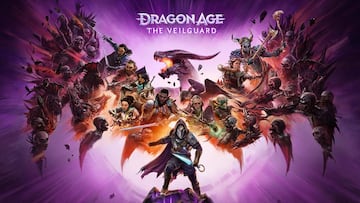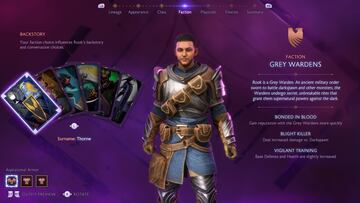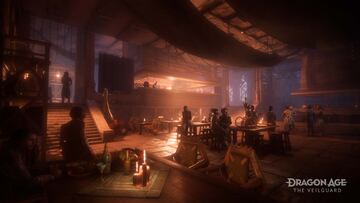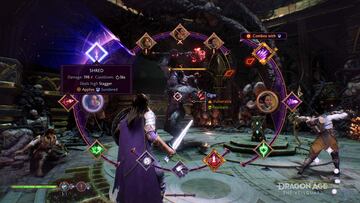Dragon Age: The Veilguard Hands-on: The magic of Thedas reappears
BioWare’s new release looks good after 8 hours of gameplay.

In the world of video games, there are places full of magic. Magic is not only about casting spells or coexisting with creatures of a different origin than humans, it is about finding characters that become truly lovable and worlds that immediately immerse us with their appearance. Thedas is one of those places, and after almost 10 years of waiting for the last Dragon Age, we are finally invited back. Inquisition won Game of the Year at the first edition of The Game Awards in 2014. The industry has changed a lot since then, and BioWare, its studio, has gone through a tough time. During a long session of almost 8 hours of gameplay, full of magic, choices and action, these are my first impressions of Dragon Age: The Veilguard.
Creating Rook
A few weeks ago, we had the opportunity to visit the Electronic Arts offices in Redwood City, California, to be among the first to return to Thedas, see some familiar faces, and pick up the story that Inquisition left behind. But first, we went through one of the most important processes: the creation of our character, nicknamed Rook.
The character creation mode allows us to customize everything to a great degree of detail, just like Inquisition allowed us to do 10 years ago. We start by choosing our lineage, not to say our race. Elf, Qunari, Human or Dwarf will be our options. After that, we move on to our appearance, first choosing if we want to be male, female, or non-binary. And yes, you can also choose your pronoun, but if you think BioWare has “gone woke” just for that option, you haven’t been following the studio’s work.
Here we move on to the whole character editing process, which gives us enough tools to customize every detail of Rook. Starting with the face, eye color, nose, teeth, to more specific aspects such as asymmetrical ears, body markings, and I must say, even impressive hair. An interesting detail is that we can also see our character in different lights, so that our choices look good no matter where in Thedas we visit.

Finally, we will choose the classic Dragon Age classes, Warrior, Rogue or Mage, which have different specializations that we will be able to learn throughout the game. We will also be able to choose our faction as part of our character’s story, which will give us certain bonuses at the time of the game. Before we start, we will be able to adjust our play style according to the experience we want to have.
Facing Dread Wolf and touring Thedas
As part of our preview, we were able to play the first few hours of Dragon Age: The Veilguard, which gave us some background on what happened in Thedas. Solas, who was revealed at the end of Inquisition to be the ancient elven god Fen’harel, the Dread Wolf, plans to restore the world to the primordial point where the Fade and the physical plane were one. Though our former companion from the previous installment knows the chaos and destruction this will cause, it is the only solution he has. 8 years have passed since Fen’harel revealed himself to the world, and Varric, one of the franchise’s most iconic characters, has a plan to stop his former comrade-in-arms and convince him not to continue his dangerous ritual.
If this is your first time in the world of Dragon Age, or it’s been a long time since you played Inquisition, and you certainly feel that not knowing the previous story or lore can be overwhelming, John Epler, Creative Director of Dragon Age: The Veilguard, mentioned to us that a balance was struck to present the game to both those new to the series and those who are fans of the franchise: “We also make the story feel fundamentally straightforward to understand. If you haven’t played the game before, the narration at the beginning of the game kind of tells you what’s at stake, but as you go deeper you’ll find, especially if you’re a Dragon Age fan and you’ve played the previous games, there’s a lot up there that we’re introducing you to, but if you already know the game there are those references.”

The world we travel through in this edition is still Thedas, but in a very different region from the one we knew in Inquisition. Beyond the visual leap that can be expected after 10 years of progress - and a generational leap in between - we find an area that has its own personality and atmosphere. Trevinter is an area that has used magic to serve and build, giving it a unique look. Each of the places visited has an appearance that shows how the development team has continued to build the world, and also shows how large each place can be, with cities like Minrathous, which functions as the capital of the empire, the fortress city of Weisshaupt, or Ventus, the coastal city in the north of the region, which in addition to its impressive streets and towns, also has a great verticality.
Visually, this is a Dragon Age we haven’t seen in a long time. In addition to a well-developed world with impressive cities and locations, the effects in terms of lightning and particle tracing make everything look magical. The textures also play an important role in these scenarios, and what to say about the weather effects.

Companions and adventures
On the other hand, we had the opportunity to meet the companions that will be part of our adventure. These companions are part of the essence of a good RPG, something that BioWare has prepared well for two generations of consoles. Although we did not interact as much as we would have liked, the ones we interacted with the most were Harding, a dwarf archer, Neve, a mage who will be our contact in Minrathous, and Bellara, a curious mechanic who is part of the Veil Jumpers. But as the story progresses, we will meet more and more companions who, following the studio’s tradition, we will have the opportunity to change what they think of us with our actions, or even form emotional bonds that end in a more formal relationship. Of the latter, we do not advance much, but we have participated in the first bonds and flirtations with those characters who had the option open.
As in previous games, we will have a place to call our base. This time, once we have progressed a bit, we will find ourselves in what appears to be an ancient fortress that Rook and his team will be able to call home within the Fade. From here, you will travel to Thedas through portals that will take you to important points in cities and regions within the realm. As the story progresses, other allies will join you and help you upgrade your weapons and armor.

As for the action, we can find something that is fast and dynamic. At the beginning we will find few enemies that will stop your progress. But as we progress, we find hordes of monsters that take over the screen. Regardless of your class, you will find ways to attack both up close and from a distance that will be very useful, and in addition, may have some synergy with your teammates through a system of effects that our powers and attacks perform.
During our time with the game, we were able to play with the 3 available classes and see which one suited us best. Warrior is the most balanced class, attacking with your sword and keeping enemies at a distance with your shield (Captain America style). On the other hand, the Rogue allows for quick attacks with the dual blades and keeping enemies at a distance with our bow. Finally, the Mage offers a variety of magics to keep enemies at a distance rather than attacking them head on. Each of these classes presents us with a skill tree that is not a simple tree, it is a forest. The game allows several specializations from which we can go taking the modes that appeal to us most. That way, if at some point we no longer like the path we are taking, or we want to try something else, we can take our points and choose something else.

Unlike Inquisition, you will only be able to take control of your character, rather than jumping back and forth between the members of your party. That doesn’t mean you can’t rely on them. You can order them to perform any of their three assigned skills, even use their powers to attack enemies or heal you if necessary, through the Skills Quick Menu. This is important because when it comes to setting up your team for the next mission, there are a number of elements that can give you an advantage over your enemies.
Classic BioWare decisions and relationships remain. Part of our experience was living through what can only be described as BioWare’s Dilemma Moments, where we had to choose between defending the attack on one of two cities, both of which have some connection to two members of your team. As our team makes their case as to why it is important to save their city, the group splits up to try and stop both attacks at the same time. However, and without going into too much detail, an accident occurs. One city manages to survive, while the other takes heavy damage. And as you can imagine, one of your companions will be grateful to you, while the other will be less so.
Thedas on the go
And of course, for those of you who have jumped on the PC laptop bandwagon, you can rest assured that you’ll be able to take the adventure with you wherever you go. During our chat with Epler, he mentioned that Dragon Age: The Veilguard is Steam Deck Verified, so you’ll be able to play it very well on Valve’s console.

For an RPG, 8 hours of gameplay is barely scratching the surface. We certainly missed being able to get more involved in the relationships and barely had a chance to see how our choices shaped this new corner of Thedas. However, we see tremendous potential in BioWare’s next adventure. Magic is in the air with new companions and a setting that seems to take advantage of all that the current generation of consoles has to offer.
Dragon Age: The Veilguard will be available on October 31st for PlayStation 5, Xbox Series X|S and PC via Steam.